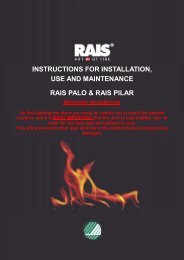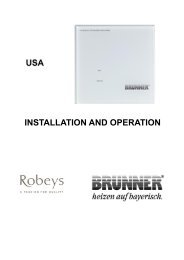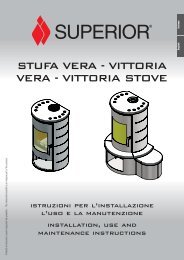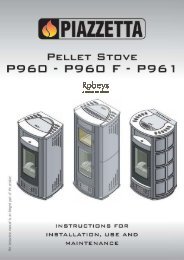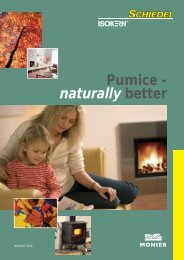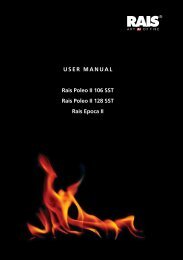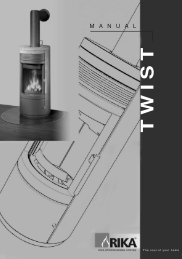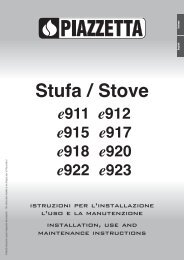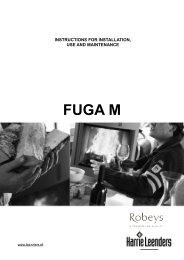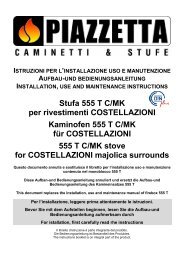instructions for installation, use and maintenance rais ... - Robeys Ltd
instructions for installation, use and maintenance rais ... - Robeys Ltd
instructions for installation, use and maintenance rais ... - Robeys Ltd
You also want an ePaper? Increase the reach of your titles
YUMPU automatically turns print PDFs into web optimized ePapers that Google loves.
ENGLISHRAIS manual <strong>for</strong> Rais Poleo <strong>and</strong> Rais EpocaInstallation distance to combustible wallTo find out whether the wall next to where the stove is going to be installed is flammable,you should contact your building contractor or the local building authorities.The hearth should be able to accommodate the weight of the stove. The chimney mustbe independently supported by wall brackets or a ceiling support plate. The weight of thestove is indicated in the brochure.The stove should always be installed on a noncombustible hearth of a size <strong>and</strong>construction that is in accordance with the provisions of the current UK BuildingRegulations Approved Document J.If the stove is to be installed on a wooden floor, it must be covered with anoncombustible material at least 12mm thick, in accordance with UK BuildingRegulations Approved Document J, to a distance of 300 mm in front of the stove <strong>and</strong>150 mm to each side measuring from the door of the combustion chamber.The clearance distances to combustible material beneath, surrounding or upon thehearth <strong>and</strong> walls adjacent to the hearth should comply with the guidance on theseparation of combustible material given in UK Building Regulations ApprovedDocument J <strong>and</strong> also in these stove <strong>instructions</strong>.Commissioning <strong>and</strong> h<strong>and</strong>overEnsure all parts are fitted in accordance with the <strong>instructions</strong>.On completion of the <strong>installation</strong> allow a suitable period of time <strong>for</strong> any fire cement <strong>and</strong>mortar to dry out, be<strong>for</strong>e lighting the stove. Once the stove is under fire check all seals<strong>for</strong> soundness <strong>and</strong> check that the flue is functioning correctly <strong>and</strong> that all products ofcombustion are vented safely to atmosphere via the chimney terminal.On completion of the <strong>installation</strong> <strong>and</strong> commissioning ensure that the operating<strong>instructions</strong> <strong>for</strong> the stove are left with the customer. Ensure to advise the customer onthe correct <strong>use</strong> of the appliance <strong>and</strong> warn them to <strong>use</strong> only the recommended fuel <strong>for</strong> thestove.Advise the <strong>use</strong>r what to do should smoke or fumes be emitted from the stove. Thecustomer should be warned to <strong>use</strong> a fireguard to BS 8423:2002 (Replaces BS 6539) inthe presence of children, aged <strong>and</strong>/or infirm persons.CO AlarmBuilding regulations require that when ever a new or replacement fixed solid fuel orwood/biomass appliance is installed in a dwelling a carbon monoxide alarm must befitted in the same room as the appliance. Further guidance on the <strong>installation</strong> of thecarbon monoxide alarm is available in BS EN 50292:2002 <strong>and</strong> from the alarmmanufacturer’s <strong>instructions</strong>.Provision of an alarm must not be considered a substitute <strong>for</strong> either installing theappliance correctly or ensuring regular servicing <strong>and</strong> <strong>maintenance</strong> of the appliance <strong>and</strong>chimney system.14



